Cherry Kharitonovskaya: variety description and cultivation
Cherry Kharitonovskaya, medium ripening. Its fruits are distinguished by good taste and high transportability.
Content:
- Description of the variety
- Growing cherry Kharitonovskaya
- Planting a seedling
- Cherry pruning
- Wood care tips
- Diseases and pests
Description of the variety
Cherry varieties Kharitonovskaya was created in the 90s of the last century. Her parents are Zhukovskaya and Almaz varieties. The tree is relatively short. It reaches a maximum of 3.5 m. The crown is spherical. Branches are dark brown. Kharitonovskaya cherry leaves are large, smooth, with large notches, dark green in color.
Cherry blooms in late April or early May. The number of flowers is large, the whole tree is covered with them. Cherries are very beautiful at the time of flowering.
The tree blooms and gives the first harvest at the age of 4-5 years.
The fruits are round. The size of each is up to 1.8 cm, weight is up to 5 g. The skin of the berries is dark red. The pulp is dense, tasty. experts estimate it at 4.3 points out of 5 possible. The bone is quite large. It takes up almost 10% of the volume.
Up to 25 kg are harvested from one tree. Medium-term berries ripen together and do not fall off the branches for a long time. They are eaten fresh, frozen, juices, jams, liqueurs are prepared. Kharitonovskaya will not give a good harvest if others do not grow next to it cherries... She is only partially self-fertile. The best pollinators for her will be Vladimirskaya, Lyubskaya. If they are not nearby, the harvest will be small, and the fruits will be small.
Growing cherry Kharitonovskaya
Cherry Kharitonovskaya grows well in sunny areas. The soil loves sandy loam, with neutral acidity. It grows poorly on clayey soils with a close occurrence of groundwater, in lowlands, where water is often collected. You should not plant young cherries in the place where another tree of the same species grew before. You need to wait at least 3 years.
The planting period depends on the region. In the south, it is better to do this in autumn, in the central zone - in early April. It is necessary to ensure that the buds on the seedling do not swell. This will significantly complicate the process of tree survival.
Choosing between a self-rooted and a grafted tree, the advantage is given to the grafted one - usually such trees tolerate frosts better and give a high yield.
Choosing a seedling with an open root system, look at the condition of the roots. They must be at least 20 cm long and alive. You can cut the spine and look at the cut. It should be light. For planting, take a tree with a well-developed root system. It is more important for further cultivation than the trunk. It can also be tested for freshness. They peel off the bark a little with a fingernail and see what color the fibers are under it. If they are green, the tree is suitable for planting, if brown, it is dry and will not take root.
A seedling with a closed root system takes root more easily, the timing of its planting increases. But you only need to buy from trusted sellers. These can be specialized nurseries, shops or gardeners known for many years of successful work in the fruit tree market.
Planting a seedling
Landing cherries better to plan ahead. Choose a site, prepare the soil for a tree. If you plan to plant a tree in the spring, prepare a hole in the fall, and for planting in the fall - in May.
How to plant cherries correctly:
- Dig a hole 1 m deep with a diameter of at least 80 cm.Stir the removed soil with two buckets of humus or compost and a half-liter jar of ash. A glass of superphosphate is added. Put the resulting mixture in a pit without ramming it.
- If the soil on the site is acidic (growing nettles and sorrel can be an indicator of this), lime it. To do this, a pound of quicklime is diluted in a bucket of water and the solution is poured into the pit. But this is not done if the pit was not prepared in advance, and it is urgently prepared three weeks before planting. In this case, it is sufficient to add only compost.
- Having bought a seedling, before planting, moisten its roots in a clay solution. The chatterbox should have the consistency of thick sour cream so that the solution stays on the roots. Heteroauxin added to the solution stimulates rapid root formation. All ingredients are thoroughly mixed until a homogeneous mass is formed.
- Having taken out of the talker, the clay is allowed to dry for about half an hour. At this time, soil is taken out of a previously prepared hole so that a planting site with a diameter of 80 cm and a depth of 60 cm is obtained. The remaining 40 cm of depth will be loose and filled with useful substances. When the roots of the tree grow to this layer, it will not be difficult for them to grow deeper. This will allow the tree to develop quickly.
- At the bottom of the recess, a mound is poured into which a stake is placed for tying the seedling. Cherries are placed on the bottom of the pit. The root collar is located 5 cm above the ground. Carefully fall asleep with soil taken out of the pit, trying to prevent the formation of voids. They will subsequently fill with earth, cutting off the young roots of the tree. For this, the barrel is periodically shaken. Having filled the hole, a mound is formed near the tree so that it reaches the root collar. When the soil settles, the roots of the seedling will not remain exposed.
- A roller is formed along the perimeter of the pit, which retains water during irrigation, without letting it go beyond the limits of the trunk circle.
- The seedling is tied up in an 8-way manner. The string will not tighten the trunk. Pour up to 3 buckets of water under the tree and mulch the area under it. Use any available materials as mulch: straw, rotted sawdust hardwoods, peat, grass cuttings. A thick layer of mulch will keep moisture from quickly evaporating from the soil.
If you need to plant several trees, the distance between them is 3 m.When planting a large number of cherries, 4 m are left in rows between them.
Cherry pruning
The first time the Kharitonovskaya cherry is cut off after planting at a height of 70 cm, the conductor is cut off. Then form the crown in the form of a bowl, leaving 3 skeletal branches. Can be formed with a guide and 5-8 skeletal branches. The guide is cut 20 cm above the upper skeletal shoot.
Pruning is done in early spring or even late February.
With the beginning of sap flow, pruning is stopped so as not to weaken the tree. In the southern regions, pruning can be carried out in the fall, after the leaves fall. The crown of the Kharitonovskaya cherry is sparse. Therefore, you do not have to prune many branches. The disadvantage is low frost resistance. Under the influence of recurrent frosts, flowers and buds may freeze slightly.
Remove broken or damaged branches, remove those that grow upward or rub against each other. The height of the tree is regulated so that it does not exceed 3 m. Otherwise, it will be problematic to harvest.
Wood care tips
How to properly care for cherries:
- Weeds or grass that grows near trees are cut down so that they do not drown out young plants. Mulch inhibits growth weeds in the near-barrel circle.
- Cherry Kharitonovskaya needs to be watered regularly. This is done every two weeks. Pour 2-3 buckets of water once. Rainy weather may be an exception. Excess moisture can lead to cracking of the berries.
- Root shoots that may appear near the tree are removed.
- Young trees of Kharitonovskaya cherry need to be insulated in winter for the first years of life. The trunks are wrapped with covering materials (agrospan) or thick paper. The first two years they are wrapped completely.
- To avoid freezing of the buds in the spring, in the snowy season, the trunk circle is covered with snow and tamped down. The thicker the snow layer, the later it will melt. The flowering time will thus be delayed by several days, which will help protect the buds from recurrent frost.
- Top dressing of adult trees is carried out several times a year. In the spring, watered with a urea solution (20 g per bucket of water). Before digging up the trunks, make universal mineral fertilizers... The third time is watered with a solution ammophos (30 g per bucket of water). In summer, it is better to carry out foliar dressing, spraying with potassium-phosphorus fertilizers. In the fall, the trunk circle is spilled with a solution mullein.
Diseases and pests
Cherry Kharitonovskaya is resistant to fungal diseases. But if the air is humid and hot, then she can get sick. Common diseases and pests of cherries:
- Powdery mildew manifests itself as a whitish bloom on leaves and young shoots. Then it turns black, the shoots stop growing. They are treated with Fitosporin, Topaz 2 times per season.
- Rust appears as orange spots on the inside of the leaf. They merge into a solid spot, the leaves wither and dry out. They are treated with Hom and Abiga-Pak preparations 6 times per season.
- Coccomycosis can be identified by brown spots on the leaves. They turn yellow and fall off. Treatment is carried out with Fitosporin, Polykhom, Ridomil every 2 weeks. The number of treatments is up to four.
- Leaves and fruits of the Kharitonovskaya cherry aphid are affected. It settles at the ends of young shoots, after which they curl up and dry out. Treated with tobacco infusion or ash, Aktara.
- Gum removal, which is not controlled, can lead to the death of the plant. When gum smudges appear on the trunks, they clean the place with a decontaminated knife to healthy wood, treat it with Bordeaux liquid.
- The cherry fly directly damages the fruit. A worm grows inside the cherry, which comes out, leaving a trail - a hole. The fruit is not suitable for consumption. Spray with Aktellik, Fitoverm, dig up the trunk circle and burn the fallen fruits.
- Cherry shoot moth damages young leaves and buds. They are treated with Karbofos.
- The leaves infect the caterpillars of winter moths. If there are a lot of them, they can eat the leaves completely, leaving only the veins. You need to fight with Confidor or other insecticides.
Clean row spacings prevent the development of diseases and pests.
More information can be found in the video:



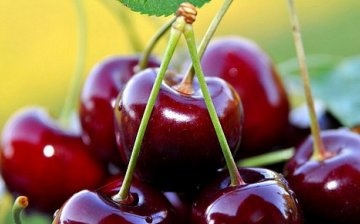
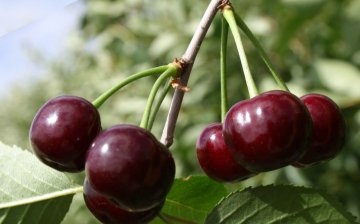
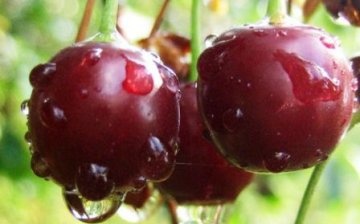
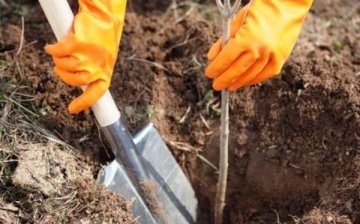
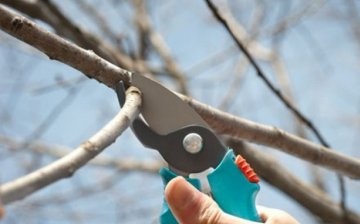
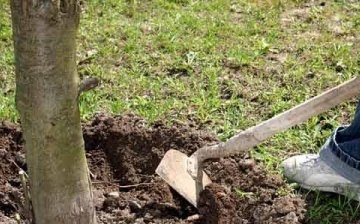
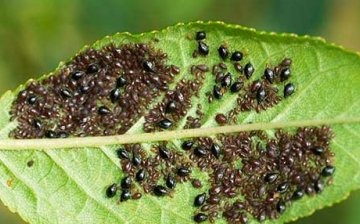







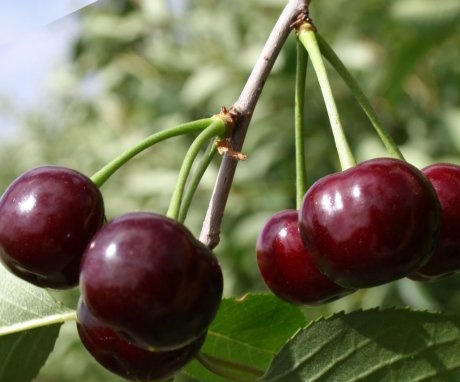
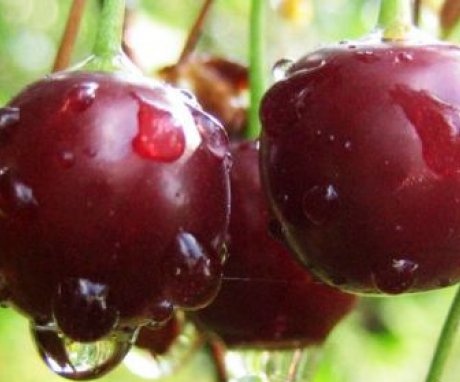
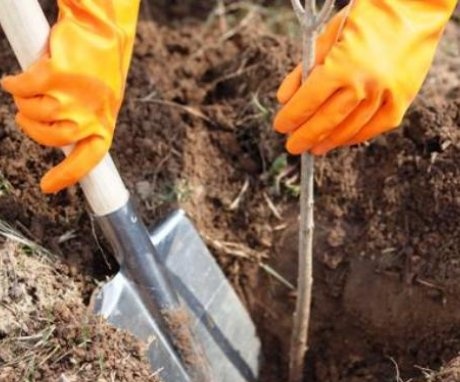
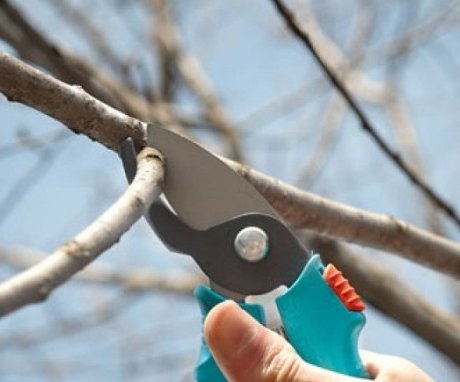
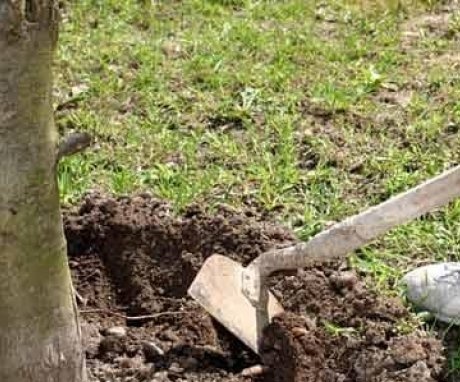
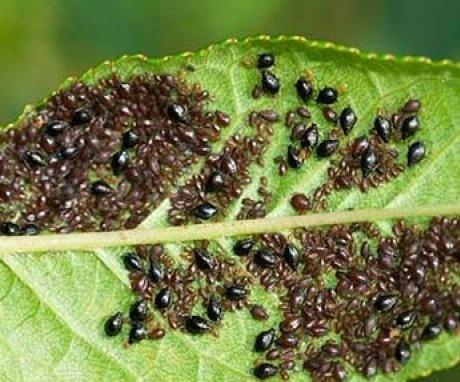
Cherry pruning is best done at a young enough age, but it is worth waiting for the tree to take root and get stronger, pruning of trees is usually carried out in the spring, forming a crown for it.